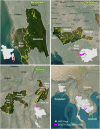Defining the hidden burden of disease in rural communities in Bangladesh, Cambodia and Thailand: a cross-sectional household health survey protocol
- PMID: 38521526
- PMCID: PMC10961499
- DOI: 10.1136/bmjopen-2023-081079
Defining the hidden burden of disease in rural communities in Bangladesh, Cambodia and Thailand: a cross-sectional household health survey protocol
Abstract
Introduction: In low-income and middle-income countries in Southeast Asia, the burden of diseases among rural population remains poorly understood, posing a challenge for effective healthcare prioritisation and resource allocation. Addressing this knowledge gap, the South and Southeast Asia Community-based Trials Network (SEACTN) will undertake a survey that aims to determine the prevalence of a wide range of non-communicable and communicable diseases, as one of the key initiatives of its first project-the Rural Febrile Illness project (RFI). This survey, alongside other RFI studies that explore fever aetiology, leading causes of mortality, and establishing village and health facility maps and profiles, will provide an updated epidemiological background of the rural areas where the network is operational.
Methods and analysis: During 2022-2023, a cross-sectional household survey will be conducted across three SEACTN sites in Bangladesh, Cambodia and Thailand. Using a two-stage cluster-sampling approach, we will employ a probability-proportional-to-size sample method for village, and a simple random sample for household, selection, enrolling all members from the selected households. Approximately 1500 participants will be enrolled per country. Participants will undergo questionnaire interview, physical examination and haemoglobin point-of-care testing. Blood samples will be collected and sent to central laboratories to test for chronic and acute infections, and biomarkers associated with cardiovascular disease, and diabetes. Prevalences will be presented as an overall estimate by country, and stratified and compared across sites and participants' sociodemographic characteristics. Associations between disease status, risk factors and other characteristics will be explored.
Ethics and dissemination: This study protocol has been approved by the Oxford Tropical Research Ethics Committee, National Research Ethics Committee of Bangladesh Medical Research Council, the Cambodian National Ethics Committee for Health Research, the Chiang Rai Provincial Public Health Research Ethical Committee. The results will be disseminated via the local health authorities and partners, peer-reviewed journals and conference presentations.
Trial registration number: NCT05389540.
Keywords: Chronic Disease; EPIDEMIOLOGY; INFECTIOUS DISEASES; Quality of Life; Risk Factors.
© Author(s) (or their employer(s)) 2024. Re-use permitted under CC BY. Published by BMJ.
Conflict of interest statement
Competing interests: None declared.
Figures


Similar articles
-
The STRATAA study protocol: a programme to assess the burden of enteric fever in Bangladesh, Malawi and Nepal using prospective population census, passive surveillance, serological studies and healthcare utilisation surveys.BMJ Open. 2017 Jul 2;7(6):e016283. doi: 10.1136/bmjopen-2017-016283. BMJ Open. 2017. PMID: 28674145 Free PMC article.
-
Defining the burden of febrile illness in rural South and Southeast Asia: an open letter to announce the launch of the Rural Febrile Illness project.Wellcome Open Res. 2022 Mar 10;6:64. doi: 10.12688/wellcomeopenres.16393.2. eCollection 2021. Wellcome Open Res. 2022. PMID: 34017924 Free PMC article.
-
Evaluation of an electronic clinical decision support algorithm to improve primary care management of acute febrile illness in rural Cambodia: protocol for a cluster-randomised trial.BMJ Open. 2024 Oct 18;14(10):e089616. doi: 10.1136/bmjopen-2024-089616. BMJ Open. 2024. PMID: 39424394 Free PMC article.
-
The spectrum of health conditions in community-based cross-sectional surveys in Southeast Asia 2010-21: a scoping review.BMC Public Health. 2024 Jul 11;24(1):1853. doi: 10.1186/s12889-024-19347-3. BMC Public Health. 2024. PMID: 38992660 Free PMC article.
-
Cholera in selected countries in Asia.Vaccine. 2020 Feb 29;38 Suppl 1:A18-A24. doi: 10.1016/j.vaccine.2019.07.035. Epub 2019 Jul 17. Vaccine. 2020. PMID: 31326255 Review.
References
-
- Life expectancy at birth (years). Available: https://www.who.int/data/gho/data/indicators/indicator-details/GHO/life-... [Accessed 23 Aug 2023].
Publication types
MeSH terms
Associated data
Grants and funding
LinkOut - more resources
Full Text Sources
Medical
Miscellaneous
